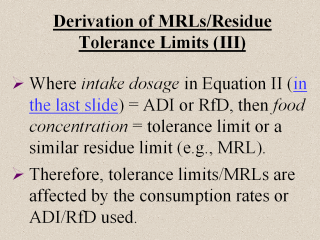 |
Furthermore, if
the value for intake dosage in Equation II in the preceding slide is
capped at a maximum level, such as by setting it equal to a pre-defined
safe intake dosage which the health risk assessment community often
refers to as acceptable daily intake (ADI) or reference dosage
(RfD), then the value so derived for food concentration becomes the
residue tolerance limit or MRL in question. Accordingly, the inconsistencies
seen in the tolerance limits across world regions (as evident in
Tables 1A,
1B, and
1C) were simply
due to the different (daily) fish consumption patterns (rates) and/or safe
dietary intake levels (e.g., ADIs or RfDs) that the different regions or
countries assumed. |
